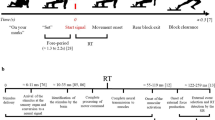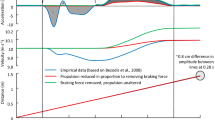Summary
Many variables have been studied pertaining to the block sprint start. Research suggests that the adoption of a medium block spacing is preferred, with front and rear knee angles in the set position approximating 90 and 130°, respectively, with the hips held moderately high. The sprinter must be capable of developing a high force rate combined with a high maximum force, especially in the horizontal direction. This ability to create high force underlies other important indicators of starting performance such as minimum block clearance time, maximum block leaving velocity and maximum block leaving acceleration. Once the sprinter has projected him/herself from the blocks at a low angle (40 to 45°) relative to the ground, the following 2 post-block steps should occur with the total body centre of gravity ahead of the contacting foot at foot strike to minimise potential horizontal braking forces.
Similar content being viewed by others
References
Tellez T, Doolittle D. Sprinting from start to finish. Track Technique 1984; 88: 2802–5
Doherty K. Track and field omnibook. 4th ed. Los Altos (CA): Tafnews Press, 1985
Dickinson AD. The effect of foot spacing on the starting time and speed in sprinting and the relation of physical measurements to foot spacing. Res Q 1934; 5 Suppl. 1: 12–9
Kistler JW. Study of the distribution of the force exerted upon the blocks in starting the sprint from various starting positions. Res Q 1934; 5 Suppl. 1:27–32
Henry MR. Force-time characteristics of the sprint start. Res Q 1952; 23(3): 301–18
Stock M. Influences of various track starting positions on speed. Res Q 1962; 33(4): 607–14
Hoster M, May E. Notes on the biomechanics of the sprint start. Athletics Coach 1979; 13(2): 2–7
Guissard N, Duchateau J, Hainaut K. EMG and mechanical changes during sprint starts at different front block obliquities. Med Sci Sports Exerc 1992; 24(11): 1257–63
Borzov V. Optimal starting position. Mod Athlete Coach 1980;18(1): 4–5
Atwater AE. Kinematic analyses of sprinting. Track Field Q Rev 1982; 82(2): 12–6
Mero A, Luhtanen P, Komi PV. A biomechanical study of the sprint start. Scand J Sports Sci 1983; 5(1): 20–8
Mero A. Force-time characteristics and running velocity of male sprinters during the acceleration phase of sprinting. Res Q Exerc Sport 1988; 94(2): 94–8
Mero A, Komi PV. Reaction time and electromyographic activity during a sprint start. Eur J Appl Physiol 1990; 61(1-2): 73–80
Levchenko A. 100 metres in 9.83: the birth of a record. Soviet Sports Rev 1988; 24(4): 182–7
Francis C, Coplon J. Speed trap. Inside the biggest scandal in Olympic history. London: Grafton Books, 1991
Sandstrom R. Improvement of acceleration. In: Jarver J, editor. Sprints and relays: contemporary theory, technique and training. Los Altos (CA): Tafnews Press, 1983
Ozolin E. The technique of a sprint start. Mod Athlete Coach 1988; 26(3): 38–9
Brüggemann G-P, Glad B. Time analysis of the sprint events. In: Brüggemann G-P, Glad B, editors. Scientific research project at the Games of the XXIVth Olympiad — Seoul 1988. Italy: Arti Grafiche Danesi, 1990: 11–90
Korchemny R. A new concept for sprint start and acceleration training. New Studies Athletics 1992; 7(4): 65–72
Baumann W. Kinematic and dynamic characteristics of the sprint start. In: Komi PV, editor. Biomechanics V-B. Baltimore: University Park Press, 1976, 194–9
Vagenas G, Hoshizaki TB. Optimization of an asymmetrical motor skill. Int J Sport Biomech 1986; 2: 29–40
Schot PK, Knutzen KM. A biomechanical analysis of four sprint start positions. Res Q Exerc Sport 1992; 63(2): 137–47
Balsevich VK. Biomechanical determinants for the rhythmic structure in sprinters start acceleration. In: Gregor RJ, Zernicke RF, Whiting WC, editors. Proceedings of the XII International Congress of Biomechanics [abstract no. 394]. Los Angeles: University of California, 1989
Van Coppenolle H, Delecluse C, Goris M, et al. Evaluation of the start action of world class female sprinters. Track Technique 1990; 112:3581–2
Van Coppenolle H, Delecluse C, Goris M, et al. Technology and development of speed: evaluation of the start, sprint and body composition of Pavoni, Cooman & Desruelles. Athletics Coach 1989; 23(1): 82–9
Gagnon MA. Kinetic analysis of the kneeling and the standing starts in female sprinters of different ability. In: Asmussen E, Jorgensen K, editors. Biomechanics Vl-B. Baltimore: University Park Press, 1978: 46–50
Payne AH, Blader FB. The mechanics of the sprint start. In: Vredenbregt J, Wartenweiler J, editors. Biomechanics II. Baltimore: University Park Press, 1971: 225–31
Mendoza L, Schöllhorn W. Training of the sprint start technique with biomechanical feedback. J Sports Sci 1993; 11: 25–9
Hafez AMA, Roberts EM, Seireg AA. Force and velocity of the front foot contact in the sprint start. In: Winter DA, editor. Biomechanics IX-B. Champaign (H): Human Kinetics Publishers, 1985: 350–1
Mero A, Komi PV, Ruskho H, et al. Neuromuscular and anaerobic performance of sprinters at maximal and supramaximal speed. Int J Sports Med 1987; 8 Suppl. 1: 55–60
Guissard N, Duchateau J. Electromyography of the sprint start. J Hum Movement Studies 1990; 18: 97–106
Wiemann K, Tidow G. Relative activity of hip and knee extensors in sprinting — implications for training. New Studies Athletics 1995; 10(1): 29–49
Author information
Authors and Affiliations
Corresponding author
Rights and permissions
About this article
Cite this article
Harland, M.J., Steele, J.R. Biomechanics of the Sprint Start. Sports Med. 23, 11–20 (1997). https://doi.org/10.2165/00007256-199723010-00002
Published:
Issue Date:
DOI: https://doi.org/10.2165/00007256-199723010-00002




